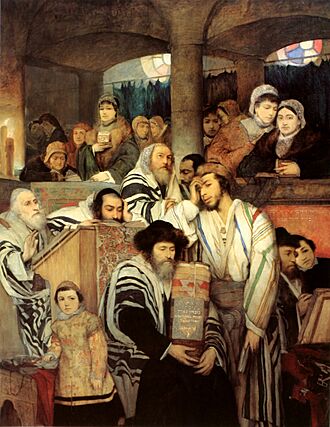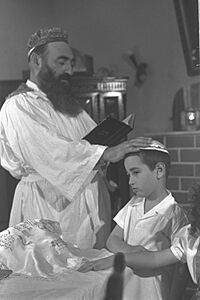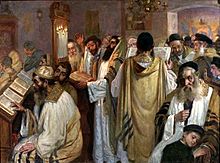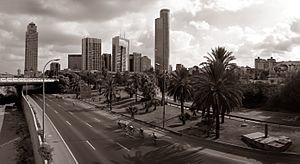Yom Kippur facts for kids
Quick facts for kids Yom Kippurיוֹם כִּפּוּר |
|
|---|---|

|
|
| Observed by | Jews and Samaritans |
| Type | Jewish, national (in Israel) |
| Significance | Atonement and repentance to God for personal sins; sealing of one's fate for the upcoming year |
| Observances |
|
| Date | 10 Tishrei |
| 2024 date | Sunset, 11 October – nightfall, 12 October |
| 2025 date | Sunset, 1 October – nightfall, 2 October |
| 2026 date | Sunset, 20 September – nightfall, 21 September |
| 2027 date | Sunset, 10 October – nightfall, 11 October |
| Frequency | Annual (Hebrew calendar) |
| Related to | Rosh Hashanah |
| Part of a series on | |||
|---|---|---|---|
|
|||
| Judaism | |||
| Category | |||
| Jewish religious movements | |||
| Orthodox (Haredi • Hasidic • Modern) | |||
| Conservative • Reform | |||
| Reconstructionist • Renewal • Humanistic | |||
| Jewish philosophy | |||
| Principles of faith • Kabbalah • Messiah • Ethics | |||
| Chosenness • Names of God • Musar | |||
| Religious texts | |||
| Tanakh (Torah • Nevi'im • Ketuvim) | |||
| Ḥumash • Siddur • Piyutim • Zohar | |||
| Rabbinic literature (Talmud • Midrash • Tosefta) | |||
| Religious Law | |||
| Mishneh Torah • Tur | |||
| Shulchan Aruch • Mishnah Berurah | |||
| Kashrut • Tzniut • Tzedakah • Niddah • Noahide laws | |||
| Holy cities | |||
| Jerusalem • Safed • Hebron • Tiberias | |||
| Important figures | |||
| Abraham • Isaac • Jacob | |||
| Moses • Aaron • David • Solomon | |||
| Sarah • Rebecca • Rachel • Leah | |||
| Rabbinic sages | |||
| Jewish life cycle | |||
| Brit • Pidyon haben • Bar/Bat Mitzvah | |||
| Marriage • Bereavement | |||
| Religious roles | |||
| Rabbi • Rebbe • Posek • Hazzan/Cantor | |||
| Dayan • Rosh yeshiva • Mohel • Kohen/Priest | |||
| Religious buildings & institutions | |||
| Synagogue • Beth midrash • Mikveh | |||
| Sukkah • Chevra kadisha | |||
| Holy Temple / Tabernacle | |||
| Jewish education | |||
| Yeshiva • Kollel • Cheder | |||
| Religious articles | |||
| Sefer Torah • Tallit • Tefillin • Tzitzit • Kippah | |||
| Mezuzah • Hanukiah/Menorah • Shofar | |||
| 4 Species • Kittel • Gartel | |||
| Jewish prayers and services | |||
| Shema • Amidah • Aleinu • Kaddish • Minyan | |||
| Birkat Hamazon • Shehecheyanu • Hallel | |||
| Havdalah • Tachanun • Kol Nidre • Selichot | |||
| Judaism & other religions | |||
| Christianity • Islam • Judeo-Christian | |||
| Abrahamic faiths | |||
| Related topics | |||
| Antisemitism • The Holocaust • Israel • Zionism | |||
Yom Kippur is the holiest day of the year in Judaism. Its name means "Day of Atonement" in Hebrew. It happens every year on the 10th day of the Hebrew month of Tishrei, which is usually in September or October.
For Jewish people, Yom Kippur is a serious and important day for thinking about the past year. It is a time to say sorry for any mistakes made, a practice known as atonement and repentance. The main ways people observe the day are by fasting (not eating or drinking) and spending a lot of time in prayer at a synagogue.
Yom Kippur is the final day of the High Holy Days, which begin with Rosh Hashanah. These ten days are known as the Days of Repentance, a time for reflection and making things right with God and other people.
Contents
What Does Yom Kippur Mean?
The full Hebrew name for the holiday is Yom HaKippurim, which means "day of the atonements." In English, it is most often called the "Day of Atonement." The shorter name, Yom Kippur, is the most common way to say it today.
Origins of the Holiday
The traditions of Yom Kippur come from the Torah, the most important holy book in Judaism. In the book of Leviticus, God tells Moses that the tenth day of the seventh month should be a special day of rest and atonement.
When the ancient Temple in Jerusalem was standing, a special service was held on Yom Kippur. The High Priest would perform special ceremonies to ask for forgiveness for all the Jewish people. Today, these services are remembered through special prayers.
Why Is Yom Kippur Important?
Yom Kippur is the most solemn day of the Jewish year. It is a day to focus on one's relationship with God and with other people.
The High Holy Days
Yom Kippur is the last day of a 10-day period called the High Holy Days, which starts with Rosh Hashanah. According to Jewish tradition, Rosh Hashanah is when God writes down what will happen to each person in the coming year in the Book of Life. On Yom Kippur, that judgment is "sealed."
During this time, Jewish people reflect on their actions from the past year. They try to make up for any wrongs they have done. A special prayer, called Unetanneh Tokef, describes this time of judgment. It also says that doing good deeds, praying, and giving to charity (tzedakah) can help make the year a better one.
Making Things Right (Teshuva)
A major theme of Yom Kippur is teshuva, which is the Hebrew word for repentance. This means feeling sorry for mistakes, deciding not to make them again, and confessing them to God.
Jewish teachings say that Yom Kippur can help a person be forgiven for sins against God. However, for mistakes made against other people, a person must first go and ask for that person's forgiveness directly. Because of this, many people spend the days before Yom Kippur apologizing to friends, family, and anyone they may have wronged.
How Is Yom Kippur Observed?
The Day Before (Erev Yom Kippur)
The day before Yom Kippur is called Erev Yom Kippur. It is a busy day of preparation.
- Asking for Forgiveness: People make a special effort to apologize to others for any hurt they may have caused.
- Festive Meal: It is a tradition to eat a large, festive meal before the fast begins at sunset.
- Charity: Some people perform a ritual called kapparot, which often involves donating money to charity.
- Blessings: It is common for parents to give their children a special blessing before the holiday starts.
Fasting and Other Restrictions
The Torah asks Jewish people to "afflict their souls" on Yom Kippur. Traditionally, this is understood to mean giving up certain physical comforts for about 25 hours, from sunset on the 9th of Tishrei until nightfall the next day. This helps people focus on spiritual matters instead of physical ones.
There are five main restrictions:
- No eating or drinking.
- No wearing leather shoes.
- No bathing or washing.
- No using perfumes or lotions.
- No marital relations.
Fasting is very important, but it is not meant to be dangerous. Anyone who is sick, very young, or pregnant is not supposed to fast. Saving a life is more important than any of these rules.
A Day of Rest
Like Shabbat, Yom Kippur is a day of rest. All forms of work are forbidden. People also wear white clothing to symbolize purity and being like angels.
Special Prayers of Yom Kippur
A large part of Yom Kippur is spent at the synagogue in prayer. The prayer services are longer than on any other day of the year. There are five services in total:
- Kol Nidre: This is the first prayer, said in the evening as the holiday begins. It is a famous and powerful prayer that asks to cancel any personal vows made to God that a person might not be able to keep.
- Shacharit: The morning prayer.
- Mussaf: An additional prayer that includes a section remembering the special service at the Temple in Jerusalem.
- Mincha: The afternoon prayer, which includes reading the Book of Jonah.
- Ne'ila: The "closing" prayer, said just before the sun sets and the holiday ends.
A key part of the prayers is the Vidui, or confession. People recite a list of sins, saying them as a community ("we have sinned") to show that everyone is responsible for each other.
The fast ends after the Ne'ila prayer, when a single long blast is blown on a shofar (a ram's horn).
Yom Kippur Around the World
In Israel
In Israel, Yom Kippur is a national holiday. The entire country comes to a stop. There are no TV or radio shows, airports and public transportation shut down, and all stores and businesses close.
The streets become completely empty of cars. It has become a popular tradition for children and teens to ride their bicycles on the empty highways. It is considered rude to eat in public on this day.
In 1973, on Yom Kippur, Israel was surprised by an attack from Egypt and Syria. This started the Yom Kippur War.
Jewish Athletes and Yom Kippur
Yom Kippur is so important that many Jewish athletes have chosen not to play in big games that fall on the holiday.
One of the most famous examples was Sandy Koufax, a Hall of Fame baseball pitcher for the Los Angeles Dodgers. In 1965, he refused to pitch in the first game of the 1965 World Series because it was on Yom Kippur. His decision was widely respected. Another famous baseball player, Hank Greenberg, did the same thing in 1934 during an important pennant race.
Date of Yom Kippur
Yom Kippur falls each year on the tenth day of the Jewish month of Tishrei, which is nine days after the first day of Rosh Hashanah. In terms of the Gregorian calendar, the earliest date on which Yom Kippur can fall is September 14. The latest Yom Kippur can occur is on October 14. Gregorian calendar dates for recent and upcoming Yom Kippur holidays are:
- Sunset, 24 September 2023 – nightfall, 25 September 2023
- Sunset, 11 October 2024 – nightfall, 12 October 2024
- Sunset, 1 October 2025 – nightfall, 2 October 2025
- Sunset, 20 September 2026 – nightfall, 21 September 2026
- Sunset, 10 October 2027 – nightfall, 11 October 2027
See also
 In Spanish: Yom Kipur para niños
In Spanish: Yom Kipur para niños
Images for kids









